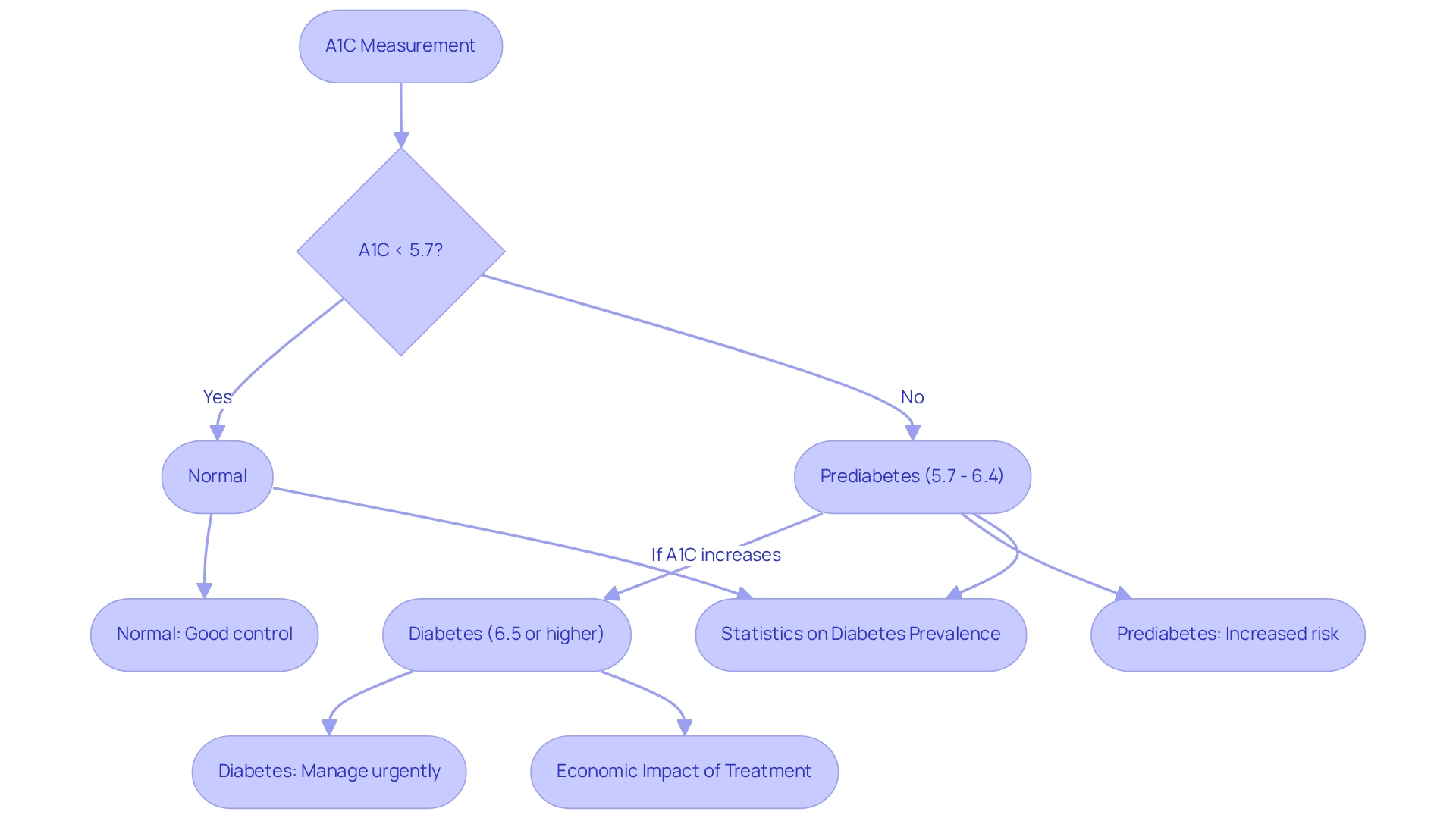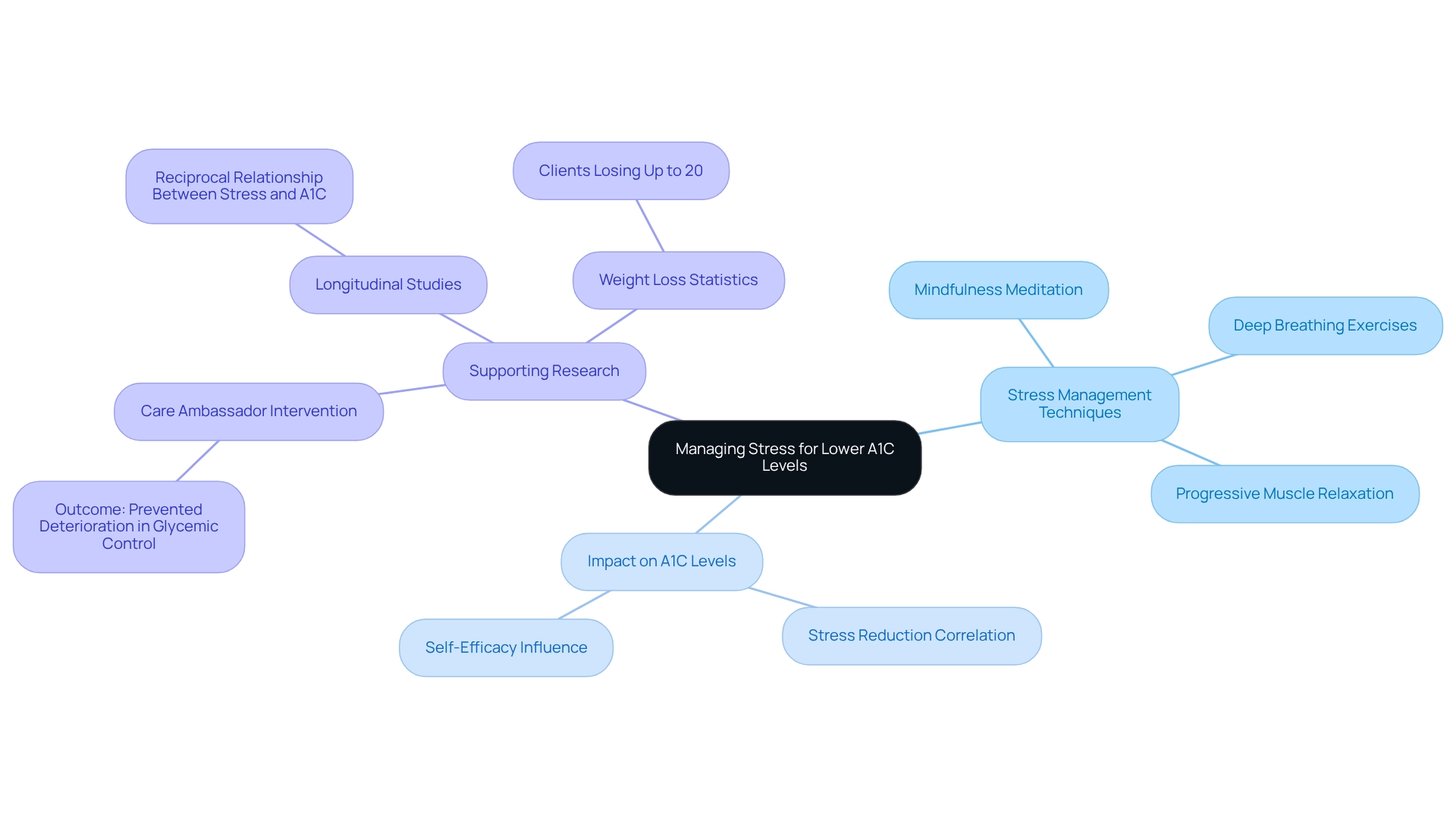Overview
If you’re looking to lower your A1C naturally, it’s important to embrace a multifaceted approach. This journey may feel overwhelming at times, but by focusing on:
- Dietary changes
- Regular physical activity
- Stress management
- Ensuring you get adequate sleep
you can make significant strides. Remember, these lifestyle modifications not only help in reducing A1C levels but also enhance your overall health and well-being.
Research supports that consistent application of these strategies leads to meaningful improvements in blood sugar control. Together, we can achieve your goals. Have you considered how small changes in your daily routine can lead to big results? By making these adjustments, you’re not just working on lowering your A1C; you’re investing in a healthier, happier you. Let’s take this journey one step at a time, and remember, we’re here for you every step of the way.
Introduction
In the quest for better health, understanding A1C levels is crucial, especially for those navigating the challenges of diabetes. A1C, a blood test that reflects average blood sugar levels over the past two to three months, serves as a vital indicator of metabolic control. As diabetes prevalence rises and complications become more common, grasping the significance of A1C is essential for effective health management.
This article gently explores the intricacies of A1C testing, while also offering natural strategies to lower these levels. We will highlight the important roles of:
- Diet
- Exercise
- Stress management
- Sleep
in achieving optimal health outcomes. By empowering you with knowledge and actionable steps, we hope to pave the way for a proactive approach to diabetes management and overall well-being. Together, we can achieve your health goals and foster a brighter future.
Understanding A1C Levels: What They Are and Why They Matter
A1C, or hemoglobin A1C, is an essential test that indicates your average glucose concentrations over the previous two to three months, expressed as a percentage. Understanding A1C values is vital for effective diabetes management, as elevated percentages can signify inadequate blood sugar control. Specifically, an A1C measurement below 5.7% is regarded as normal, while readings between 5.7% and 6.4% imply prediabetes, and figures of 6.5% or higher signify diabetes.
The importance of A1C measurements goes beyond simple categorization; they can indicate potential diabetes-related issues, such as heart disease and nerve damage. Did you know that recent statistics reveal that 47.4% of U.S. adults with diagnosed diabetes have an A1C value of 7.0% or higher? This highlights the urgent need for effective management strategies. Furthermore, the age-adjusted prevalence of total diabetes has risen from 9.7% in 1999–2000 to 14.3% as of August 2023, according to Qiuping Gu, M.D., Ph.D. This underscores the growing public health challenge we face together.
Additionally, the median county-level incidence of diagnosed diabetes was 9.7 per 1,000 people in 2004 and decreased to 9.0 per 1,000 people in 2020. This trend provides historical context on diabetes prevalence, showing that while progress has been made, there is still work to be done.
Consistent assessment of A1C readings is essential for helping healthcare professionals modify treatment strategies aimed at lowering A1C naturally to enhance blood sugar management. For instance, studies indicate that average medical expenditures for individuals with diagnosed diabetes are 2.6 times higher than those without diabetes. This emphasizes the economic impact of effective diabetes management and the importance of taking action.
Real-world examples demonstrate how A1C measurements can predict complications. Individuals with persistently elevated A1C values are at a higher risk for cardiovascular problems and neuropathy. As specialists in the area highlight, tracking A1C values is not merely about controlling diabetes; it serves as a proactive strategy for lowering A1C naturally and averting serious medical issues.
Furthermore, the stability in undiagnosed diabetes prevalence, with approximately 4.5% of adults having undiagnosed diabetes as of August 2021-August 2023, suggests a need for improved screening and awareness efforts. Together, we can identify and treat individuals who are unaware of their diabetes status. This thorough comprehension of A1C testing enables individuals to take control of their well-being and strive for improved results. Remember, we’re here for you on this journey towards better health.
Natural Strategies to Lower A1C: An Overview
A multifaceted strategy that includes dietary changes, enhanced physical activity, stress management, and overall lifestyle modifications is essential for lowering A1C naturally. These strategies not only aid in reducing A1C levels but also improve overall wellness and well-being. At Minimal, we offer personalized weight loss solutions and holistic health treatments that can complement these strategies effectively.
Have you ever felt overwhelmed by the journey to better health? You’re not alone. Many individuals struggle with managing their A1C levels, but there are compassionate and effective strategies available to help you on this path.
- Balanced Diet: Emphasizing a diet rich in whole foods, particularly those high in dietary fiber, can significantly impact blood sugar control. Research indicates that higher fiber intake is associated with a reduced risk of type 2 diabetes, highlighting the importance of incorporating fruits, vegetables, whole grains, and legumes into daily meals. As noted by Dong Wei, “Higher intake of dietary fiber has been proven to be associated with a decreased risk of T2DM.” At Minimal, we provide tailored nutrition guidance to help you make these dietary changes with confidence.
- Regular Physical Activity: Participating in consistent exercise is essential for enhancing insulin sensitivity and keeping blood sugar stable. Research indicates that individuals who boost their physical activity can attain significant decreases in A1C over time. For example, a case study involving American Indian and Alaska Native participants showed that those who improved their physical activity and made better food choices experienced a statistically significant reduction in A1C values by the third year of the program. At Minimal, we offer personalized fitness plans designed to support your efforts and celebrate your progress.
- Stress Management: Chronic stress can adversely affect blood sugar levels. Applying mindfulness methods, such as meditation or yoga, can help reduce stress and enhance overall well-being outcomes. At Minimal, we incorporate stress management strategies into our comprehensive wellness treatments to support your journey toward a healthier life.
- Adequate Sleep: Quality sleep is essential for metabolic well-being. Suboptimal sleep patterns can result in insulin resistance, complicating the management of blood sugar concentrations effectively. Our programs at Minimal emphasize the importance of sleep hygiene as part of a comprehensive approach to health.
Statistics reveal that nearly 47.4% of U.S. adults diagnosed with diabetes have an A1C value of 7.0% or higher, underscoring the need for effective lifestyle interventions. However, there’s hope—many individuals have effectively reduced their A1C readings through lifestyle modifications. Clients at Minimal have achieved up to 20% weight reduction, closely associated with enhanced glycemic control. Together, we can explore the effectiveness of various dietary approaches, including low-carbohydrate diets, to improve outcomes in diverse populations and settings.
In summary, adopting these natural strategies can be beneficial for lowering A1C while promoting a healthier lifestyle. By focusing on dietary changes, physical activity, stress management, and sleep hygiene, you can take proactive steps toward better health and diabetes management, supported by the personalized services offered by Minimal. Remember, we’re here for you—together, we can achieve your goals.
Dietary Changes: Foods to Include and Avoid for Lowering A1C
To effectively reduce A1C values, it’s important to prioritize foods that are high in fiber, low in refined sugars, and nutrient-dense. Consider incorporating a variety of non-starchy vegetables, whole grains, lean proteins, and healthy fats into your diet. Excellent choices include:
- Leafy greens
- Beans
- Lentils
- Whole grains like quinoa and brown rice
- Healthy fats from avocados and nuts
These foods not only supply vital nutrients but also assist in enhancing insulin sensitivity and stabilizing sugar levels. On the other hand, it’s essential to steer clear of:
- Sugary drinks
- Processed snacks
- Items high in saturated fats
As these can adversely affect sugar regulation. Reducing your consumption of refined carbohydrates, like white bread and pastries, can also be beneficial in sustaining stable sugar concentrations.
Striving for a balanced meal that highlights whole, unprocessed foods can greatly assist your wellness objectives. Have you considered how these changes might impact your daily life?
Studies suggest that individuals with prediabetes should target seven to eight hours of sleep each night, as sufficient rest plays a crucial role in glucose regulation. Consistent tracking of A1C, blood pressure, and cholesterol values is vital for those at risk of or diagnosed with prediabetes, ensuring proactive management of well-being. Together, these factors work with dietary changes to create a comprehensive approach to health management.
Incorporating specific foods into your diet can yield positive results. For instance, citrus fruits, while containing natural sugars, are low to medium on the glycemic index and rich in fiber and beneficial compounds like naringenin, which may improve insulin sensitivity. Eating whole citrus fruits can assist in regulating blood sugar levels effectively. By focusing on these dietary modifications, you can make substantial progress toward lowering A1C naturally.
As Dr. Chance Miller highlights, clients value the customized focus from a committed care team at Minimal, which is essential in managing A1C measurements efficiently. By aligning these dietary recommendations with Minimal’s personalized weight loss solutions and holistic wellness treatments, you can work towards achieving long-term well-being outcomes. Remember, we’re here for you, and together, we can achieve your goals.
The Role of Exercise: How Physical Activity Affects A1C Levels
Engaging in regular physical activity is a cornerstone strategy for lowering A1C naturally and effectively. Health experts recommend aiming for a minimum of 150 minutes of moderate-intensity aerobic exercise each week. Activities like brisk walking, cycling, or swimming not only enhance cardiovascular function but also play a crucial role in improving insulin sensitivity.
Moreover, including strength training workouts at least twice weekly can enhance these advantages, supporting weight management and metabolic function.
At Minimal, we understand that integrating exercise into your routine can be challenging. We’re here for you. Our personalized health and wellness programs are designed to support you in implementing these exercise recommendations effectively. By merging customized fitness plans with dietary advice, we assist you in developing a balanced strategy for lowering A1C naturally.
Research highlights the positive effect of consistent exercise on A1C values. For instance, an extensive 8-year trial conducted by researchers from Tabriz University of Medical Sciences demonstrated that regular exercise training significantly improved HbA1c levels, body mass index (BMI), and overall fitness among patients with type 2 diabetes mellitus. This study emphasizes how sustained physical activity can aid in lowering A1C naturally, resulting in significant wellness improvements and reinforcing the importance of exercise in diabetes management.
Moreover, activities that promote flexibility and stress reduction, such as yoga and tai chi, can also contribute to better blood sugar control. These practices not only improve physical well-being but also promote mental wellness, which is essential for effective diabetes management. Minimal’s holistic approach ensures that you have access to resources that address both physical and mental well-being aspects of your journey.
Current guidelines from health organizations advocate for a balanced approach to exercise, emphasizing both aerobic and resistance training. A mix of these exercise types has been demonstrated to produce better outcomes in lowering A1C naturally compared to either type of exercise on its own. As observed by Timothy S. Church, MD, MPH, PhD, “Among individuals with type 2 diabetes mellitus, a combination of aerobic and resistance training in comparison to non-exercise control enhanced HbA values; this was not accomplished by aerobic or resistance training independently.”
This reinforces the effectiveness of a comprehensive exercise regimen.
Moreover, statistics show that the average change in kilocalories consumed daily at follow-up was -127 for the combination training group, further reinforcing the advantages of exercise on A1C values.
As you begin your fitness journey, it is crucial to consult with your medical provider, particularly if you have pre-existing medical issues. Medical approval is advised for inactive adults prior to engaging in moderate-to-high intensity exercise, ensuring a safe and efficient method for lowering A1C naturally. With minimal support, you can navigate this journey with confidence and achieve your health goals.
Managing Stress: Techniques to Support Lower A1C Levels
Chronic stress can significantly impact your blood sugar levels, making effective stress management essential for reducing A1C. Have you ever noticed how stress affects your daily life? Research indicates that stress can disrupt glycemic regulation, leading to elevated A1C values. Thankfully, techniques such as mindfulness meditation, deep breathing exercises, and progressive muscle relaxation can help alleviate stress and enhance your overall well-being.
At Minimal, we understand the importance of these stress management techniques. They can be seamlessly integrated into personalized weight loss solutions and holistic wellness treatments, offering a comprehensive approach to your well-being. For instance, a study involving a care ambassador intervention for youths with Type 1 Diabetes revealed that behavioral family interventions could prevent deterioration in glycemic control among participants with A1C readings above 8.0%. This underscores the potential of structured support in managing stress and improving health outcomes through our patient-centered programs.
Incorporating enjoyable activities into your daily routine can also play a crucial role in reducing stress. What hobbies bring you joy? Engaging in meaningful moments with family and friends and cultivating gratitude are effective methods that can help. Setting aside dedicated time each day for relaxation and self-care not only fosters a sense of calm but also supports better blood sugar management.
Recent studies highlight the interconnectedness of stress and glycemic regulation, suggesting that as stress diminishes, A1C values may improve. According to Mahmood Karimy, an Assistant Professor at Saveh University of Medical Sciences, “there is a strong negative correlation between self-efficacy and stress,” indicating that individuals with higher self-efficacy can manage their stress more effectively. Additionally, many clients in our wellness programs at Minimal have successfully lost up to 20% of their weight, based on data from over 70,000 patients who participated for at least six months. This emphasizes the significance of stress management in achieving improved well-being outcomes.
By incorporating these stress management methods within the framework of Minimal’s comprehensive wellness solutions, you can take proactive steps toward healthier glucose readings and overall well-being. Remember, we’re here for you, and together, we can achieve your goals.
The Importance of Sleep: How Rest Affects A1C Levels
Quality sleep is essential for sustaining stable blood sugar rates. Did you know that studies show people who obtain 7 to 9 hours of restorative sleep each night enjoy improved metabolic health? Unfortunately, poor sleep can significantly raise insulin resistance, leading to higher A1C readings. A study on patients with Type 2 Diabetes revealed that those with HbA1c readings of 7% or higher had significantly poorer sleep quality. This finding emphasizes the importance of addressing sleep issues for effective glycemic control.
At Minimal, clients have reported losing an average of 15-20% of their weight, based on data from over 70,000 patients who participated for at least six months. This underscores the connection between sleep quality and weight management. Often, this weight loss is supported by medications like Ozempic and Wegovy, which are part of Minimal’s personalized wellness approach. Together, we can achieve and sustain your weight loss goals through tailored fitness and nutrition plans, regular progress check-ins, and comprehensive support.
To enhance your sleep hygiene, consider implementing the following strategies:
- Establish a consistent sleep schedule
- Create a calming bedtime routine
- Limit screen time before bed to reduce blue light exposure
Additionally, ensure your sleep environment promotes rest—keep the room dark, quiet, and cool. If you continue to experience sleep difficulties, consulting a healthcare provider can offer tailored guidance and support.
As Dr. Chance Miller highlights, clients value the individualized focus from a committed care team at Minimal, which can be vital in addressing sleep problems and incorporating holistic wellness treatments.
By prioritizing sleep quality, you can make substantial progress toward lowering A1C naturally and improving your overall well-being. The Berlin questionnaire (BQ) can also be employed for screening obstructive sleep apnea syndrome (OSAS), further highlighting the significance of evaluating sleep quality in relation to metabolic wellness. Statistical analyses performed using SPSS software have shown a clear relationship between metabolic parameters and sleep quality, reinforcing the need for effective sleep hygiene practices as part of a comprehensive health care strategy.
Monitoring Progress: The Role of Healthcare Providers in Lowering A1C
Regular consultations with healthcare providers are vital for effectively tracking A1C readings and making necessary adjustments to treatment plans aimed at lowering A1C naturally. Have you ever felt overwhelmed by managing your health? Research shows that patients who actively engage with their healthcare teams are more likely to achieve improved A1C levels through methods designed for natural reduction. By setting realistic goals and tracking your progress with your provider, you can significantly enhance your management strategy.
It is recommended to arrange A1C tests every three to six months, tailored to your specific wellness needs. This proactive approach not only facilitates timely adjustments to your treatment but also empowers you to make informed decisions regarding dietary and lifestyle changes. Remember, open communication with your healthcare team fosters a cooperative atmosphere, which is crucial for successfully managing your wellness journey.
As highlighted by Hee-Chung Kang, PhD, “These findings stress the significance of regular HbA1c testing in enhancing the future well-being outcomes of patients with type 2 diabetes.” Furthermore, the financial implications of diabetes management are significant, with the excess medical costs per person increasing from $10,179 in 2012 to $12,022 in 2022. Understanding A1C results is essential for accurate diabetes management, particularly in the context of strategies for lowering A1C naturally, as illustrated in case studies on interpreting HbA1c results.
Additionally, the rising incidence of type 2 diabetes among U.S. children and adolescents underscores the importance of A1C monitoring across different demographics. Consistent oversight of A1C values is essential for enhancing long-term health outcomes, especially for individuals focused on lowering A1C naturally while managing diabetes. Together, we can achieve your goals and improve your health journey.
Key Takeaways: Your Action Plan for Lowering A1C Naturally
To effectively reduce your A1C values naturally, consider implementing the following action steps:
- Comprehend Your A1C Values: Start by understanding what A1C values signify regarding your glucose regulation over the previous two to three months. The A1C test evaluates hemoglobin with bound glucose, offering insight into your glucose concentrations. This understanding is crucial for tracking your progress.
- Implement Dietary Changes: Focus on incorporating fiber-rich foods such as whole grains, legumes, fruits, and vegetables into your meals. These foods assist in stabilizing sugar concentrations. At the same time, steer clear of refined sugars and processed foods that can lead to spikes in glucose amounts. Minimal offers personalized nutrition guidance to help you make these dietary changes effectively.
- Engage in Regular Physical Activity: Aim for at least 150 minutes of moderate-intensity exercise each week, as recommended by the American Diabetes Association. This can include activities like brisk walking, cycling, or swimming. Consistent physical activity not only aids in controlling sugar amounts but also supports general health and weight regulation. Minimal’s tailored fitness plans can support you in achieving your exercise goals.
- Manage Stress: Ongoing stress can adversely affect glucose concentrations. Incorporate mindfulness practices, such as meditation or yoga, and relaxation techniques into your daily routine to help manage stress effectively. Minimal provides resources to help you integrate these practices into your lifestyle.
- Prioritize Quality Sleep: Establish a consistent sleep routine to ensure you get adequate rest. Poor sleep can disrupt hormonal balance and affect blood sugar control, making it essential to prioritize sleep hygiene.
- Regular Monitoring: Collaborate closely with your healthcare provider to routinely check your A1C readings. This will help you assess the effectiveness of your lifestyle changes and make necessary adjustments. Minimal promotes regular progress check-ins to support your wellness journey.
- Explore Different Approaches: Some individuals have achieved success with different approaches, such as cupping therapy, with 7.60% of participants indicating its use in regulating blood sugar. Minimal also examines different alternative therapies that may aid in your health management.
By adhering to these steps, you can take proactive control of your health and strive towards attaining optimal A1C results. Research shows that individuals who make lifestyle adjustments can significantly enhance their A1C readings, with many achieving optimal results through lowering A1C naturally and persistent effort. Real-life examples illustrate that with commitment, individuals have successfully focused on lowering A1C naturally, highlighting the effectiveness of these methods.
As health coaches often emphasize, taking control of your health through lifestyle changes is not just beneficial; it is empowering. Minimal’s holistic approach further supports individuals in managing their A1C levels effectively, reinforcing the company’s unique position in the wellness industry.
Conclusion
Understanding A1C levels is essential for effective diabetes management and overall health. This article emphasizes the critical role of A1C testing in monitoring blood sugar control and preventing potential complications. By recognizing the significance of maintaining A1C levels below 5.7%, you can take proactive steps towards better health outcomes.
Implementing natural strategies such as dietary modifications, regular physical activity, stress management, and prioritizing quality sleep can significantly lower A1C levels. These lifestyle changes not only contribute to improved glycemic control but also enhance your overall well-being. Emphasizing a diet rich in fiber, engaging in consistent exercise, managing stress effectively, and ensuring adequate sleep are all vital components of a comprehensive approach to diabetes management.
Collaboration with healthcare providers is crucial in this journey. Regular monitoring and open communication can lead to personalized treatment plans that adapt to your individual needs. By following the outlined action steps and embracing a holistic approach to health, you can empower yourself to achieve optimal A1C levels and foster a brighter, healthier future. Taking control of your health through informed decisions and lifestyle changes can lead to significant improvements in A1C levels and your overall quality of life.
Frequently Asked Questions
What is A1C and why is it important?
A1C, or hemoglobin A1C, is a test that indicates average glucose concentrations over the previous two to three months, expressed as a percentage. It is crucial for diabetes management, as elevated A1C values can signify inadequate blood sugar control and potential diabetes-related issues.
What do different A1C values indicate?
An A1C measurement below 5.7% is considered normal, 5.7% to 6.4% indicates prediabetes, and 6.5% or higher signifies diabetes.
How prevalent is diabetes in the U.S.?
Recent statistics show that 47.4% of U.S. adults diagnosed with diabetes have an A1C value of 7.0% or higher. The age-adjusted prevalence of total diabetes has risen from 9.7% in 1999–2000 to 14.3% as of August 2023.
What historical trends are observed in diabetes incidence?
The median county-level incidence of diagnosed diabetes decreased from 9.7 per 1,000 people in 2004 to 9.0 per 1,000 people in 2020, indicating some progress in diabetes management.
Why is consistent assessment of A1C readings necessary?
Consistent A1C assessments help healthcare professionals modify treatment strategies to lower A1C levels naturally, which enhances blood sugar management and reduces the economic impact of diabetes.
What complications are associated with elevated A1C values?
Individuals with persistently elevated A1C values are at a higher risk for complications such as cardiovascular problems and neuropathy.
What lifestyle strategies can help lower A1C naturally?
Effective strategies include adopting a balanced diet rich in whole foods, engaging in regular physical activity, managing stress, and ensuring adequate sleep.
How does a balanced diet contribute to A1C management?
A diet high in dietary fiber, including fruits, vegetables, whole grains, and legumes, can significantly impact blood sugar control and reduce the risk of type 2 diabetes.
What role does physical activity play in managing A1C levels?
Regular exercise enhances insulin sensitivity and stabilizes blood sugar levels, leading to significant decreases in A1C over time.
How can stress management techniques affect A1C levels?
Chronic stress can negatively impact blood sugar levels; mindfulness practices like meditation or yoga can help reduce stress and improve overall well-being.
Why is sleep important for metabolic health?
Quality sleep is essential for metabolic well-being; poor sleep patterns can lead to insulin resistance, making blood sugar management more challenging.
What support is available for individuals working to lower their A1C?
Organizations like Minimal offer personalized weight loss solutions and holistic health treatments to support individuals in managing their A1C levels effectively.



















